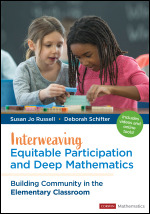Interweaving Equitable Participation and Deep Mathematics
Building Community in the Elementary Classroom
Corwin Mathematics Series
Creating mathematical community in elementary classrooms to support equitable engagement in deep mathematical content
What does a mathematical community look like in an elementary classroom? How do teachers engage young mathematicians in deep and challenging mathematical content? How do we ensure that every student contributes their voice to this community?
Interweaving Equitable Participation and Deep Mathematics: Building Community in the Elementary Classroom focuses on a dual commitment: to teaching deep and challenging mathematics and to equitable participation for all students in the classroom community. With practical strategies and real-life examples, Susan Jo Russell and Deborah Schifter offer a design for building community organized around four key aspects: every voice matters; collaboration supports student agency; student-created representations offer anchors, openings, and depth; and students become initiators and advocates for their own learning. Each chapter examines how teachers implement these ideas through video examples from six public elementary-school classrooms.
A powerful resource for any educator interested in a mathematics education that fosters a true sense of community, this book
- Provides a window into a learning community of educators applying their understanding of mathematics to develop a teaching practice that fosters students’ curiosity, meaning-making, and mathematical agency
- Presents vivid examples of teachers and students in diverse classrooms engaged in rich mathematical tasks and deep collaborative conversations, inviting readers to reflect on their practices and students' learning
- Engages readers in math investigations to help them understand student thinking, provides reflection questions about the classroom video, and offers suggestions for taking next steps in one's own practice
- Includes commentaries on the videos by a group of “critical friends”—educators with deep experience in mathematics and equity—and by the teachers of the classrooms in the videos
- Offers free online tools for professional development and book study groups, including a Facilitator’s Guide and a Notes Organizer, and suggests resources for continued learning.
This book is a must-read for anyone passionate about creating positive change in the mathematics education system and ensuring that every student has the opportunity to thrive in their mathematical journey.
Interweaving Equitable Participation and Deep Mathematics includes commentaries by:
Collaborating Teachers:
Quayisha Clarke, Emmanuel Fairley-Pittman, Natasha Gordon, Jeff Parks, Isabel Schooler, and Michelle Sirois
Critical Friends:
Cindy Ballenger, Virginia Bastable, Yi Law Chan, Marta Garcia, Lynne Godfrey, Hetal Patel, and Darlene Ratliff
While reading this book and watching the videos, I found myself wishing that I had read it when I was a classroom teacher. The authors give readers a window into a learning community of educators as they apply their new sense-making about mathematics to their teaching. While the academic content is mathematics, we are guided through the creation of a community where each learner’s sense of self and agency is strengthened around their own learning.
This book is a must-read for math educators across K–12 who want to foster curiosity, meaning making, and collective mathematical agency in our nation’s diverse classrooms. The authors and their teacher-leader partners provide multiple resources that illustrate equitable community-focused instruction where students take charge of and practice essential mathematical skills including representing, conjecturing, and generalizing. Powerful!
This resource provides images of teaching that promote student voice and agency in mathematics classrooms. The authors’ creative approach—with video clips, transcripts, and commentaries from collaborating teachers and critical friends—will engage teachers, coaches, and leaders across the professional continuum. The images, mathematical representations, questions, and activities will transform your thinking and practice and ultimately elevate student participation and learning.
I sum up Interweaving Equitable Participation and Deep Mathematics as: Deep Mathematics Content + Community Participation that leads toward equitable engagement, growth, and outcomes. Teachers and leaders can engage in deep professional learning throughout the sections in this book and will reflect on their practices and students’ learning.
Central to this book is the valuing and foregrounding of children’s mathematical thinking. Through classroom videos and supporting reflection prompts and activities, the authors show the interplay of providing rich mathematical experiences and focusing on equitable participation. This results in a powerful resource for teachers, teacher educators, and anyone interested in a mathematics education that honors all children’s ideas.
In this exciting book, Russell and Schifter invite us to join their professional learning community to explore teaching that interweaves a commitment to equity and rigorous mathematics. Each chapter offers vivid examples of teachers and students engaged in rich mathematical tasks and deep collaborative conversations in their classrooms. It really is a privilege to reflect alongside these authors. I can’t wait to share this book with my teacher education students.
Together with collaborating teachers and critical friends, Russell and Schifter take us into inspirational and real classrooms, revealing the complexities and insights that come with taking students’ intellects seriously and nurturing equitable classroom communities. This book invites rich reflection and entices you to move with urgency and eagerness to develop your mathematics teaching and make real your commitments to racial equity. You will return to it again and again.
Russell and Schifter have created a remarkable resource for teachers to gather around! The authors have expertly combined rich videos with insightful analysis and thought-provoking questions. Readers will have the best sort of collaborative, empowering opportunities to grow both a deep understanding of mathematics teaching and learning and their capacity to provide equitable instruction to all students. This book is a gift!


